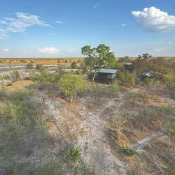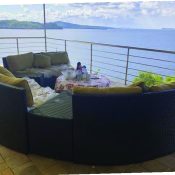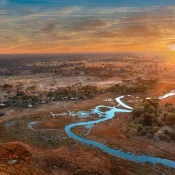
In what Great Plains has termed “one of the largest wildlife translocations in wildlife history” a consignment of 3000 animals is to be relocated from Save Valley Conservation to three different conservancies. The initiative has generally received a thumbs up from wildlife experts and will see the animals going on a road journey of approximately 700 hundred kilometres to their new homes. With all the reservations attached to translocation and its questionable efficiency it is regarded much better than the alternative which would have to be culling.
Save Valley Conservancy sees average to below average rainfall and hotter temperatures in general. The reserve attracts a sizable number of tourists and visitors because of the diversified wildlife species it supports. Most of Southern Africa’s game species including the Big Five (elephant, lion, leopard, buffalo and rhino) can be found in their herds and prides so one can only imagine the pressure on resources. Despite Save Valley Conservancy being one of the largest reserves in the whole of Southern Africa, with
a footprint of 750 000 acres, it can no longer support the growing populations of animals due mainly due to loss of habitats brought about by climate change, infrastructural development and the growing human population.
With the global decline of wildlife populations, overpopulation might sound like a positive sign for wildlife in the Save Valley Conservancy but it becomes a problem when there is a scarcity of water and food and a loss of habitat for the animals. Successive droughts and hotter temperatures in the Eastern Lowveld in which Save Valley Conservancy is located has not been easy on both the animals and humans, resulting in conflict as animals are starting to encroach into human settlements in search of food and water.
Couple that with climate change and what you get is an area which is close to unhabitable. Animals which have a low resistance to harsher weather patterns and conditions like elephants, buffalo and antelope have particularly been at risk. The translocation of some of the animals (elephants, lions, buffalo, eland, zebras, impala and painted dogs) from Save Valley Conservancy will relieve the pressure on resources for the animals and ultimately the human beings who are also part of the ecosystem while providing the translocated animals a sanctuary of some sort.
The animals are being relocated to Sapi Reserve, Mavhuradonha Wilderness Area and Chizarira National Park. These locations have been identified as ideal for a number of important reasons.
Sapi Reserve is a private concession on 280,000 acres along the Zambezi Valley which is run by Great Plains Foundation, a non-governmental organisation concerned with the conservation and expansion of natural habitats. From the 1950s up until 2017 Sapi was primarily a hunting concession and decades of unrestricted hunting eventually resulted in low wildlife populations. For a reserve which has among its aims to recover and increase wildlife populations, protect and enhance biodiversity, a consignment from the Save Valley Conservancy would surely do them good. Besides, the Sapi Reserve is far from being the drought stricken Save Valley Conservancy as it benefits from the Zambezi River water which translates to rich vegetation good for the animals in terms of fodder and habitat.
The translocation programme, which is going to take two years, has led to a barrage of opportunities for the locals who live around the conservancy through community involvement programmes, outreach and bursaries. There is also going to be consistent assessments on the impact of the translocations on resident populations.
Mavhuradonha Wilderness Area is also a good choice because of the numerous streams and rivers passing through the area.
The Mavhuradonha Wilderness Area, which covers 600 square metres of land is considered sacred. This means that the wild areas are seldom visited by even the local dwellers which equates to lower levels of poaching and longer life spans for the animals. The relocated animals would be safer and better off in this kind of environment.
The third location proposed, Chizarira National Park, is also ideal for a translocation destination. Chizarira National Park is the fourth largest park in Zimbabwe with relatively pristine fauna and flora as a result of its proximity to the Zambezi Valley and the Upper Waters of Lake Kariba. Its remoteness provides a deterrent for poachers ultimately reducing the levels of poaching and safeguarding the animals.
This initiative, fronted by Great Plain Foundation with support from the Government and ZIMPARKS, is the only chance of ensuring both the survival of the animals and the easing of pressure on the resources. There is also the possibility of the Save Valley Conservancy having its biodiversity restored in the long run.
Recent Wildlife Translocations Elsewhere in Africa
According to The International Union for Conservation of Nature there are three different types of translocations namely reintroductions, reinforcement or supplementation, and introductions.
In the case of reintroductions, there is an intentional movement and release of plants or animals within their indigenous range from which they have disappeared. This is the case with what has been labeled a “grand experiment” which will see cheetahs being reintroduced in India’s Kuno National Park about 75 years after the last cheetah in the nation was gunned down. The translocation of the cheetahs from Namibia has been met with much criticism as most people are not finding the logic behind reintroducing a species in an environment in which it was poached into extinction.
Some question whether India still has the same ideal natural habitats that enabled cheetahs to thrive long back.
The Peace Parks Foundation, another conservation group with headquarters in South Africa, has been doing an incredible job with their ReWild Africa initiative which has seen them facilitating the translocation of 25,000 animals across southern Africa national parks since they started the initiative in 2001. Recently, they successfully translocated critically endangered black rhino to Zinave National Park in Mozambique from Manketti Game Reserve in South Africa.
text by Farai Chaka
All Categories
Recent Posts
Kazuma Safari Camp –
Kariba’s Kumabirira Lodge Is The Perfect Hideaway
Contact Us
+263 789 532 918




